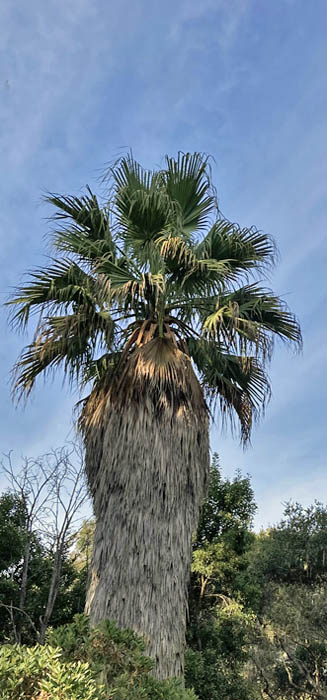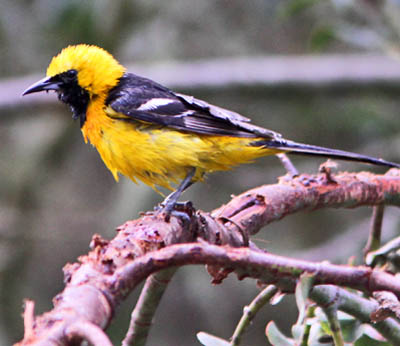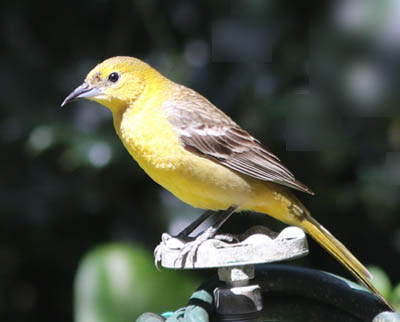
a web page by Don Roberson |
 |
|||||
ICTERIDS Icteridae New World orioles, blackbirds, cowbirds and allies |
|||||
|
|||||
While icterids exhibit a wide variety of lifestyles — from solitary to densely colonial —- the longish, slim, and pointed beaks of most species help to identify them as a family. This is easily noted on Western Meadowlark (left). The haunting and lilting notes of its song are readily heard in the open plains of western North America. A different songster is the East (Eastern Meadowlark Sturnella magna) and a third population, currently assigned to Eastern Meadowlark, is in the American southwest (and may be split eventually as Lilian's Meadowlark S. lilianae). The five meadowlarks in South America are red-breasted in color pattern. Bright primary colors contrasting with jet black plumage is a common color combination among the Icteridae. Orioles and caciques are examples, but so is Yellow-rumped Marshbird (below), a denizen of the swampy pampas from southern Brazil south into Argentina and Uruguay. |
|||||
|
|||||
Scott's Oriole (right, a male) is a black-and-yellow oriole of the southwestern United States, where it frequents pinyon-juniper woods, agaves, and Joshua trees. It is a short-distant migrant in winter, withdrawing into northwestern Mexico. On its breeding grounds, its song somewhat recalls that of Western Meadowlark. Many resident orioles reside in the tropics. There are seven species endemic to Caribbean islands in varying patterns of black-and-yellow, exemplified by Santa Lucia Oriole (below left) and Cuban Oriole (below right), but the 8th endemic, the Jamaican Oriole (second row below), is quite different in color pattern and is not closely related to the others (Fraga 2011).
|
|||||
|
|||||
|
|||||
Among complex innovations of the Icteridae are nests consisting of delicately woven hanging baskets by orioles, caciques, and some colonial oropendulas. In the example above, sixty or so Montezuma Oropendula nests hang from a single tree (above left); an adult Montezuma Oropendula is shown high in a forest tree (above right). Another widespread species — Crested Oropendula (below left) — surveys its domain on Trinidad. |
|||||
|
|||||
|
|||||
Another mostly solitary and rather secretive forest icterid is Jamaican Blackbird (left). It is apt to be found in the forest canopy or skulking in the undergrowth. Genetic evidence suggests it is close to the ancestral stem of the Icteridae, and has no close living relatives (Fraga 2011). The traditional view had been that what used to be called "Bay-winged Cowbird Molothrus badius" of southern South America was a primitive, non-parasitic cowbird. It was thought that it might be an incipient parasite as there were sometimes extra eggs in its nest. Then it was shown that it was no cowbird at all (Fraga 1972, Jaramillo & Burke 1999). It was moved to genus Agelaioides, acquired a new English name, and just recently split into two species: Grayish Baywing Agelaioides badius (southern Brazil to Argentina) and Pale Baywing A. fringillarius (eastern Brazil). Both species are actually cooperative breeders, with up to six helpers attending a nest. Grayish Baywing (below) incubates their own eggs and rear their own young (often with helpers) but often care for eggs and young of the Screaming Cowbird Molothrus rufoaxillaris, a brood parasite that almost exclusively parasitizes Grayish Baywing (Fraga 1983). The nesting behavior of Pale Baywing is similar, and its nests are often parasitized by Shiny Cowbird Molothrus bonariensis. |
|||||
|
|||||
In North America, the common brood parasite is Brown-headed Cowbird (above & begging fledgling below). Its mating system differs geographically, and it can be promiscuous, polygynous, polyandrous, or monogamous. This adult male in my back yard in central California (above) bows, shivers its wings, raises its ruff, and gurgles to entice a female. The female will then surreptitiously lay eggs in an open cup nest of a small passerine. In the photo (below) the host in my yard was a Dark-eyed Junco, seen feeding the huge begging fledgling that is bigger than the adult junco. Brood parasitism is interesting biologically, and has been the subject of several scholarly books (Rothstein & Robinson 1998, Ortega 1998). Unfortunately, in California, brood parasitism — combined with major losses in riparian habitat — has devastated local populations of vireos, flycatchers, and warblers that build open-cup-style nests. A century ago cowbirds were restricted in California to the Colorado River border with Arizona, but the spread of agriculture opened up habitat and provided food for cowbirds which rapidly spread everywhere (reaching Monterey Co. in the 1920s and the Oregon border by 1960; Laymon 1987). The most susceptible birds declined rapidly, particularly the California races of Willow Flycatcher (Unitt 1987) and Bell's Vireo (Franzreb 1987). Both are severely endangered today. Brown-headed Cowbirds parasitize a wide variety of species. Locally, we documented nine hosts during the Monterey Breeding Bird Atlas (Roberson & Tenney 1993) and suspected several more. In a wider view, though, cowbird brood parasitism is fascinating where hosts and parasites have co-evolved in New World tropics (as in Giant Cowbirds and oropendulas). |
|||||
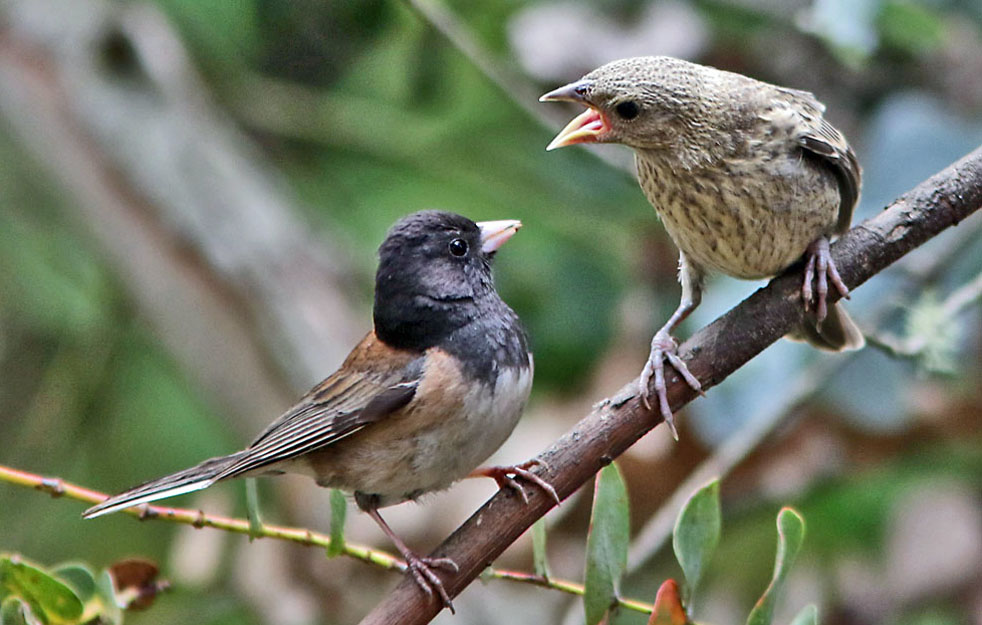 |
|||||
Many icterids are "black birds" — the term "blackbird" is used in a variety of genera (not to mention some thrushes in the Old World) — and some familiar black species are grackles and cowbirds. Among those bearing a formal English name of Blackbird, there is a diversity of plumage pattern and behaviors. Two striking colonial species, at least as adult males, show convergent evolution although not otherwise closely related and nearly poles apart in distribution: the western North American Yellow-headed Blackbird (below left) and southern South American Scarlet-headed Blackbird (below right). Each is assigned to a monotypic genus. Yellow-headed is numerous in prairie wetlands but smaller colonies dot western North America. Flocks migrate to the southern U.S. and Mexico for winter. Scarlet-headed Blackbird is a beautiful resident of reedbeds from southeast Brazil to Bolivia. These colonies are scarce and local. The head coloration of both sexes seem to glow, and is said to have impressed even Theodore Roosevelt during his travels through Brazil. |
|||||
|
|||||
We can contrast that with a shot of Tricolored Blackbird on breeding territory (right, male above and female below). This very colonial species is almost endemic to California, but has lost many colonies to agriculture over time and become a threatened species. Males have crimson-red lesser coverts and contrastingly bright white median coverts — often only the white portion is shown in the field. Females are very dark below with a blackish belly, which is a pattern also shown by "Bicolored" Red-winged Blackbirds in California. [This female is carrying vegetation for nest-building.] Both Red-winged and Tricolored Blackbirds are in genus Agelaius. Three other species of Agelaius are endemic to Caribbean islands, and two are restricted to Cuba: Red-shouldered Blackbird A. assimilis and Tawny-shouldered Blackbird (below; two glossy males foraging in a flowering tree). Unrelated to these blackbirds is the huge Oriole Blackbird Gymnomystax mexicanus, widely distributed in South America. It is larger than most orioles, is predominantly golden-yellow with a black back, wings, and tail, and wears a short black mustache. Its Latin name (mexicanus) is one of those taxonomic misnomers. There are none in Mexico. |
|||||
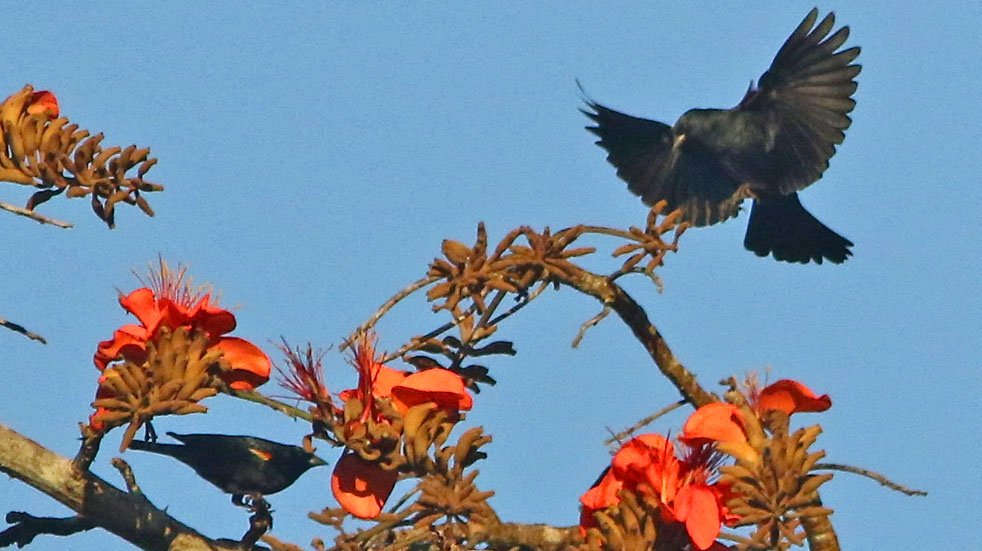 |
|||||
A close relative is Rusty Blackbird (fall male below), a somewhat mysterious bird of northern wooded wetlands from Alaska to Labrador. It generally migrates to the southeastern United States for winter, and a few vagrants are found annually in California (where this photo was taken). The entire population is in a long-term decline, and I see fewer Rusty Blackbirds out west now then I did some 40 years ago. [This one is about to swallow a fly]. |
|||||
|
|||||
All the Quiscalus grackles are loud and noisy — this Greater Antillean Grackle (male, right) is giving us an ear-full in Cuba. Its range includes Jamaica, Hispaniola, Puerto Rico and the Caymans. I lack much experience with three remaining genera of grackles in South America: Red-bellied Grackle Hypopyrrhus pyrohypogaster; Velvet-fronted Grackle Lampropsar tanagrinus; and Mountain Grackle Macroagelaius subalaris and Golden-tufted Grackle M. imthurni. In the birding world, there is always something more to learn and to see. Icterids are often considered the most recently-evolved of birds, and in some formulations (e.g., the 16 volumes of Handbook of Birds of the World), the Icteridae are the final Family (Fraga 2011). Page 807 of Volume 16 ends with Western Meadowlark. A more recent arrangement (Barker et al. 2013, now adopted by the AOS) places them just in front of New World Warblers (Paridae), but still very near to the end of the entire taxonomy. |
|||||
|
|||||
Photos: The shot of a flock of icterids and pigeons includes many Tricolored Blackbirds Agelaius tricolor (and a few Red-winged and Brewer's Blackbirds); it was taken at Moonglow Dairy, Moss Landing, California, USA, on 20 Jan 2017. The Western Meadowlark Sturnella neglecta was also at Moonglow Dairy on 1 Oct 2016. The two Yellow-rumped Marshbird Pseudoleistes guirahuro in flight were at Emas NP, Brazil, on 25 July 2010. The male Baltimore Oriole Icterus galbula was at Chinchora, Costa Rica, on 19 Dec 2007. The Scott's Oriole Icterus parisorum was at Hereford, Arizona, on 4 May 2015. The St. Lucia Oriole Icterus laudabilis was Fregate Island Reserve, St. Lucia, on 19 Mar 2000. The Cuban Oriole Icterus melanopsis was at Cuevo Porto, Cuba, on 6 Feb 2017. The Jamaican Oriole Icterus leucopteryx was at Green Castle, Jamaica, on 16 Feb 2017. The nest of Montezuma Oropendula Psarocolius montezuma were along Achiote Road, Panama, in Jan 1991, and the oropendula itself at La Selva, Costa Rica, on 18 Dec 2007. The Crested Oropendula Psarocolius decumanus was at Asa Wright Reserve, Trinidad, in Dec 2006. The Yellow-rumped Cacique Cacicus cela was displaying at its nest west of Cuiaba, Mato Grosso, Brazil, in Aug 1999. The Red-rumped Cacique Cacicus haemorrhous and the Golden-winged Cacique Cacicus chrysopterus were at Intervales NP, Brazil, on 2 Aug 2010. The Jamaican Blackbird Nesopsar nigerrimus was at Hardwire Gap, Blue Mountains, Jamaica, on 17 Feb 2017. The Grayish Baywing Agelaioides badius was in the Brazilian Pantanal on 19 July 2010. Both the displaying Brown-headed Cowbird Molothrus ater, and the fledgling being fed by a Dark-eyed Junco Junco hyemalis, were in my Pacific Grove, CA, backyard on 23 May 2015 and 7 July 2016, respectively. The Giant Cowbird Molothrus oryzivorus was along the Rio Claro, Brazilian Pantanal, on 19 July 2010. The vagrant hatch-year Bobolink Dolichonyx oryzivorus was at Pt. Pinos, Pacific Grove, CA, on 10 Oct 2008. The Yellow-headed Blackbird Xanthocephalus xanthocephalus was at Dechambeau marsh, Mono Co., CA, on 25 May 2009. The male Scarlet-headed Blackbird Amblyramphus holosericeus was in the Brazilian Pantanal on 18 July 2010. The male "Bicolored" Red-winged Blackbird Agelaius phoeniceus was near Salinas, CA, on 1 Apr 2018, and the more typical female was at Magee Marsh, Ohio, USA, on 21 May 2019. The pair of Tricolored Blackbird Agelaius tricolor were at Fort Ord Nat'l Monument, CA, on 22 Apr 2012. The two Tawny-shouldered Blackbird Agelaius humeralis were at Cuevo Puerto, Cuba, on 6 Feb 2017. The two male Brewer's Blackbird Euphagus cyanocephalus were, respectively, sun-bathing at Pt. Pinos, CA, on 10 July 2016, and puddle-bathing in Seaside, CA, on 2 Aug 2017. The fall male Rusty Blackbird Euphagus carolinus was a vagrant in Monterey, CA, on 28 Oct 2013. The male Great-tailed Grackle Quiscalus mexicanus was at Zmudowski SB, Monterey Co., CA, on 29 Apr 2017. The male Greater Antillean Grackle Quiscalus niger was at Las Terraze, Cuba, on 5 Feb 2017. The pair of Hooded Oriole Icterus cucullatus that have nested in our palm in Pacific Grove, CA, were photographed on 10 June 2014 (male) and 15 Apr 2017 (female). All photos © Don Roberson; all rights reserved. Family book: Rating
Literature cited:
|
|||||
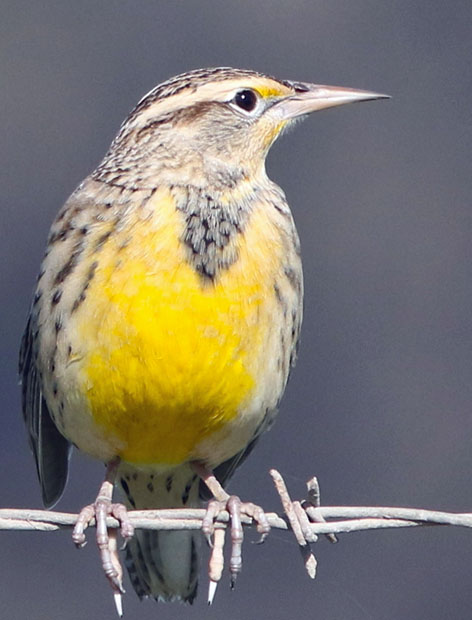 The Icterids are a large group of strong-billed passerines limited in distribution to the New World. They have been called the "New World Blackbirds" or the "Troupials and Allies" or any number of monikers, but it is easiest to think of them as "Icterids." The group includes the bright New World orioles, troupials, and oropendulas; the glossy black grackles, cowbirds, and various "blackbirds" in differing genera; songsters such as meadowlarks; and some unique long-distance migrants. Some equatorial or island species are solitary and scarce, while some North American species can be abundant, with huge flocks darkening the sky — a small slice of a central California flock of 5000 icterids with 3 species of blackbirds at a dairy (above), also includes some Rock Pigeons.
The Icterids are a large group of strong-billed passerines limited in distribution to the New World. They have been called the "New World Blackbirds" or the "Troupials and Allies" or any number of monikers, but it is easiest to think of them as "Icterids." The group includes the bright New World orioles, troupials, and oropendulas; the glossy black grackles, cowbirds, and various "blackbirds" in differing genera; songsters such as meadowlarks; and some unique long-distance migrants. Some equatorial or island species are solitary and scarce, while some North American species can be abundant, with huge flocks darkening the sky — a small slice of a central California flock of 5000 icterids with 3 species of blackbirds at a dairy (above), also includes some Rock Pigeons. 
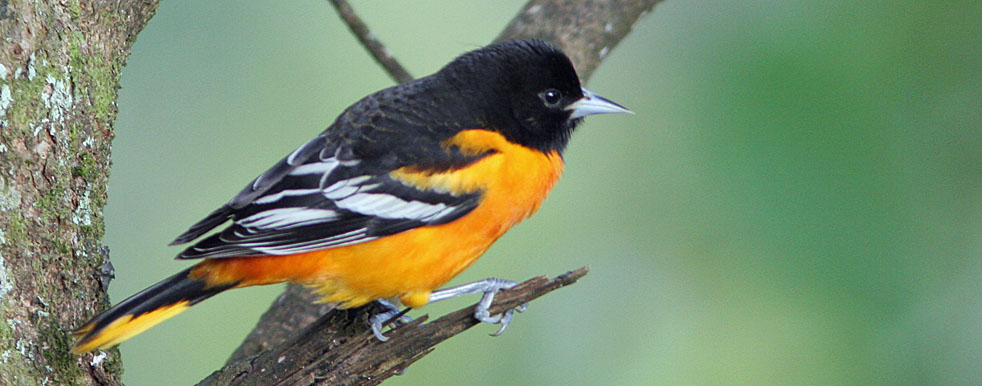
 The 32 orioles and troupials in the genus Icterus are a colorful group. Black-and-orange or black-and-yellow are featured in the plumages of many males. Baltimore Oriole (a male is shown above) is widespread and well-known to the public in eastern North America, not only as a conspicuous and beautiful bird, but also the eponym for the Baltimore Orioles major league baseball team. It, like most other North American orioles, are migratory. Baltimes flies to Central and northwest South America for winter. As a migrant, strays will occur out of normal migratory paths (including once to my backyard birdbath in California).
The 32 orioles and troupials in the genus Icterus are a colorful group. Black-and-orange or black-and-yellow are featured in the plumages of many males. Baltimore Oriole (a male is shown above) is widespread and well-known to the public in eastern North America, not only as a conspicuous and beautiful bird, but also the eponym for the Baltimore Orioles major league baseball team. It, like most other North American orioles, are migratory. Baltimes flies to Central and northwest South America for winter. As a migrant, strays will occur out of normal migratory paths (including once to my backyard birdbath in California). 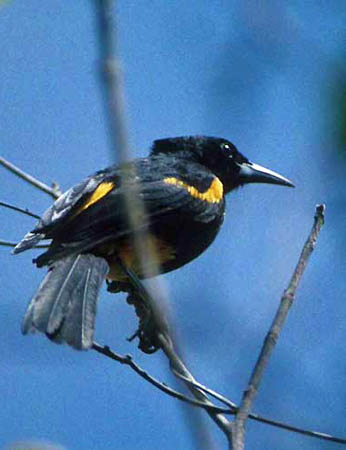
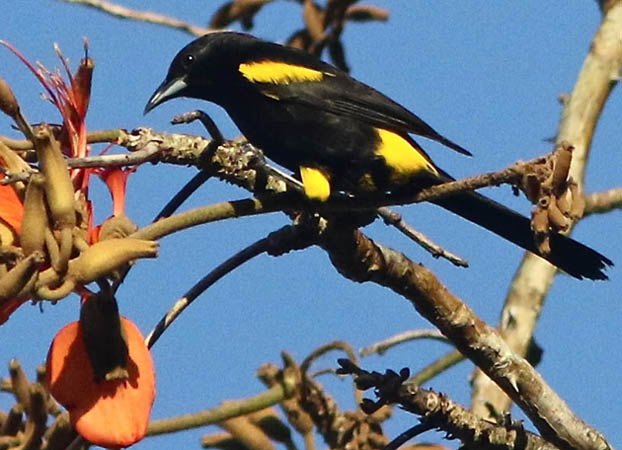

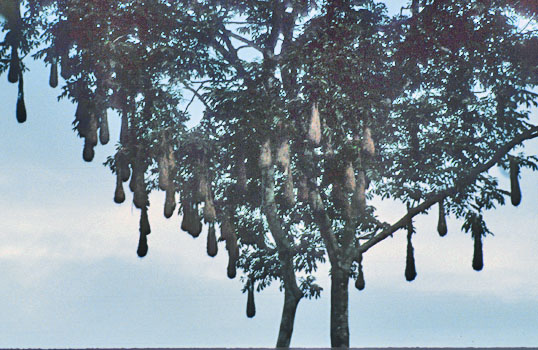
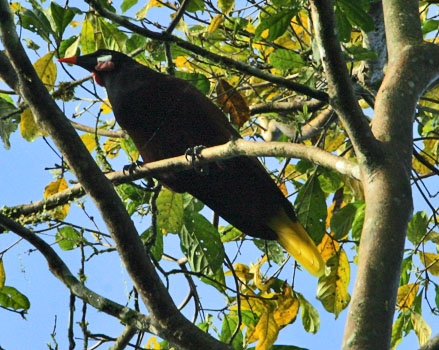
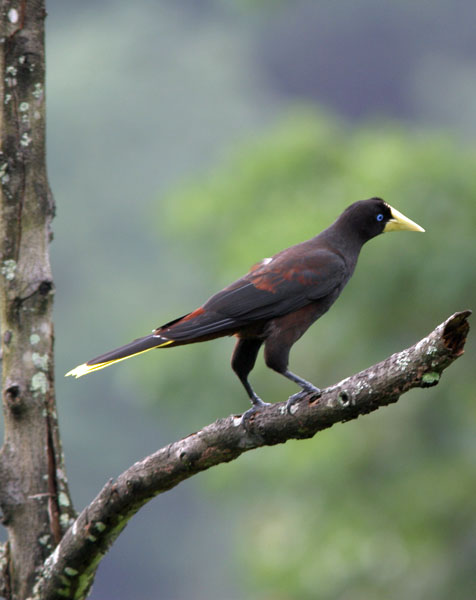
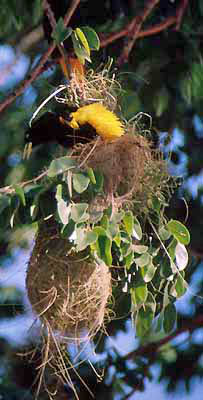

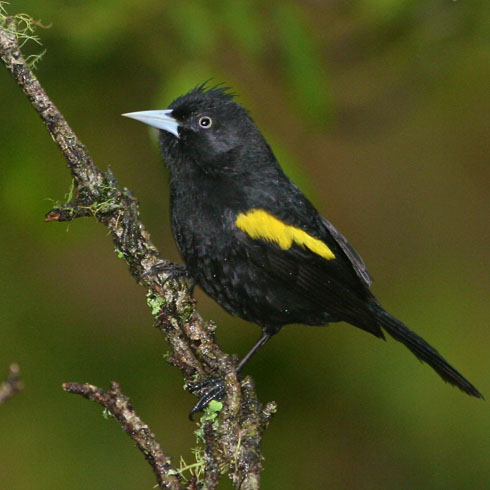
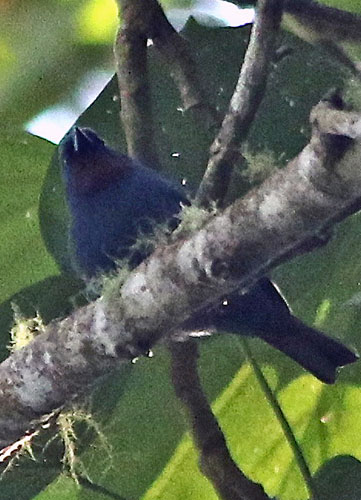 There are colonial caciques (e.g., Yellow-rumped) and then there are more or less solitary caciques. Two such solitary forest caciques are shown above from southeastern Brazil: Red-rumped Cacique (above left) and Golden-winged Cacique (above right).
There are colonial caciques (e.g., Yellow-rumped) and then there are more or less solitary caciques. Two such solitary forest caciques are shown above from southeastern Brazil: Red-rumped Cacique (above left) and Golden-winged Cacique (above right). 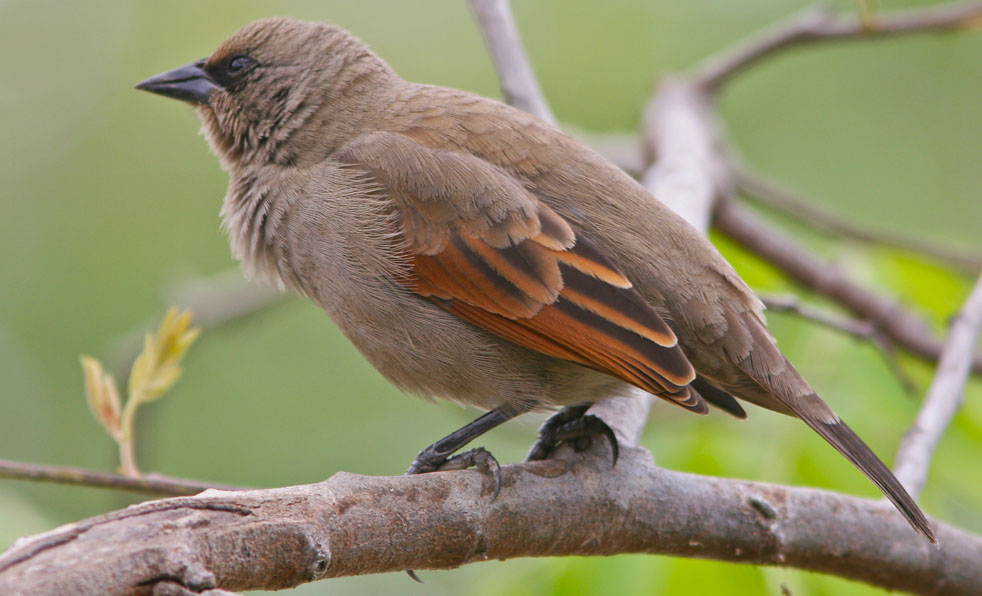
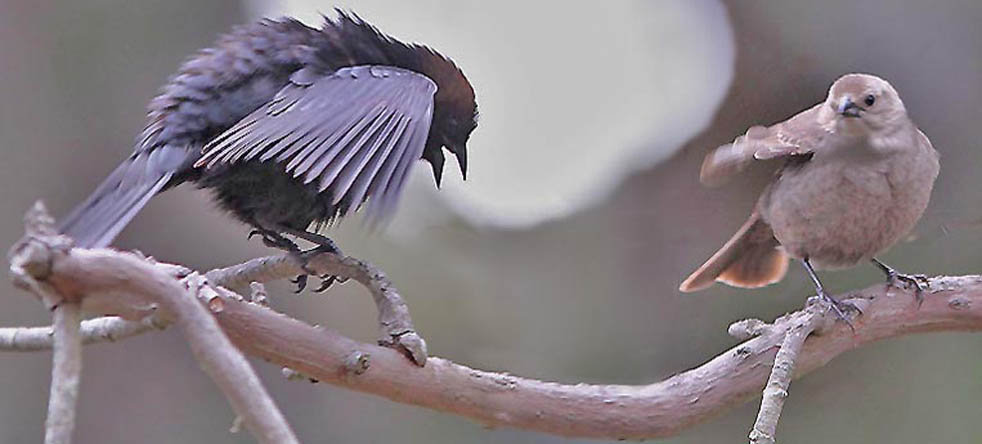
 There are now five species of parasitic cowbirds in genus Molothrus. One widespread Neotropical species is huge, and males much larger than females. It is Giant Cowbird (right). During the breeding season, adults frequent oropendula colonies, where it lays its eggs in oropendola nests and relies on them to raise its offspring.
There are now five species of parasitic cowbirds in genus Molothrus. One widespread Neotropical species is huge, and males much larger than females. It is Giant Cowbird (right). During the breeding season, adults frequent oropendula colonies, where it lays its eggs in oropendola nests and relies on them to raise its offspring.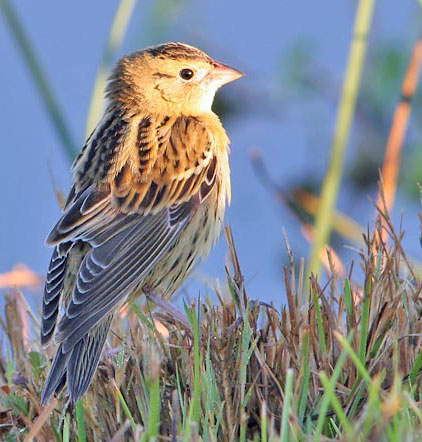 A very unique icterid is the highly migratory Bobolink. Breeding in the prairies and open fields of middle and eastern North America, males on territory have black heads and underparts with patches of buffy cream and white above, but females and youngsters are camouflaged in brown. This migrant hatch-year Bobolink (left), sitting in reeds at Crespi Pond in Pacific Grove, CA, where it is quite rare, is in an immature plumage. Bobolinks fly all the way to southern South America for the winter.
A very unique icterid is the highly migratory Bobolink. Breeding in the prairies and open fields of middle and eastern North America, males on territory have black heads and underparts with patches of buffy cream and white above, but females and youngsters are camouflaged in brown. This migrant hatch-year Bobolink (left), sitting in reeds at Crespi Pond in Pacific Grove, CA, where it is quite rare, is in an immature plumage. Bobolinks fly all the way to southern South America for the winter.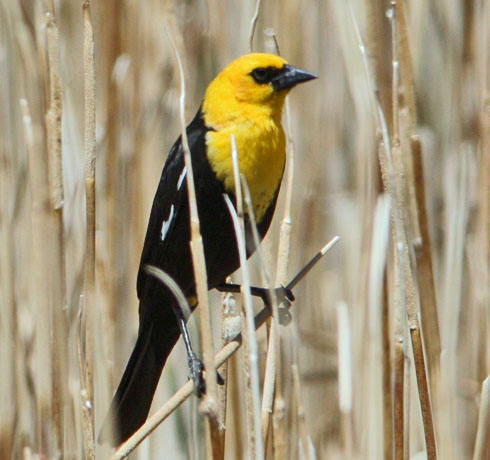
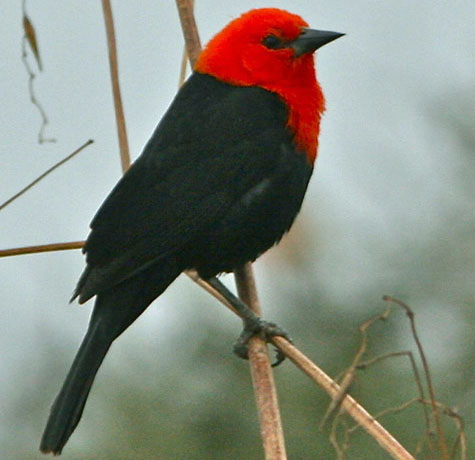
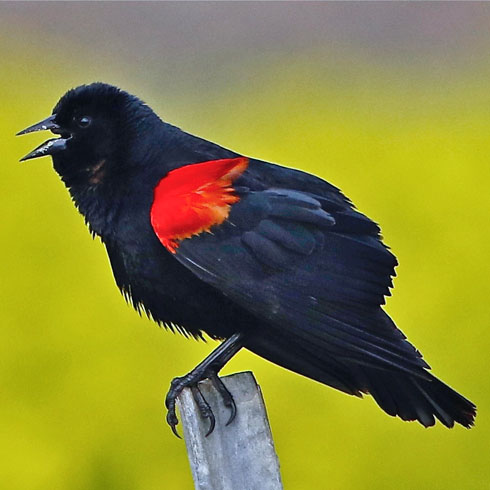
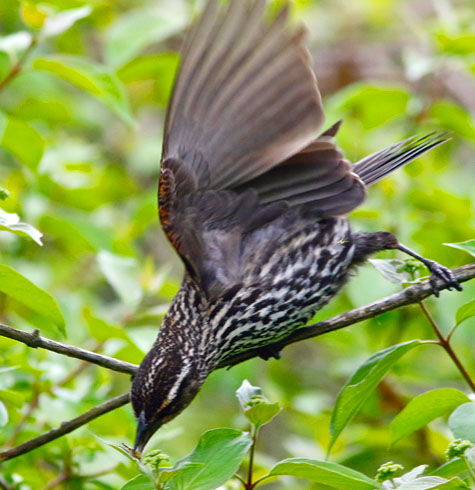
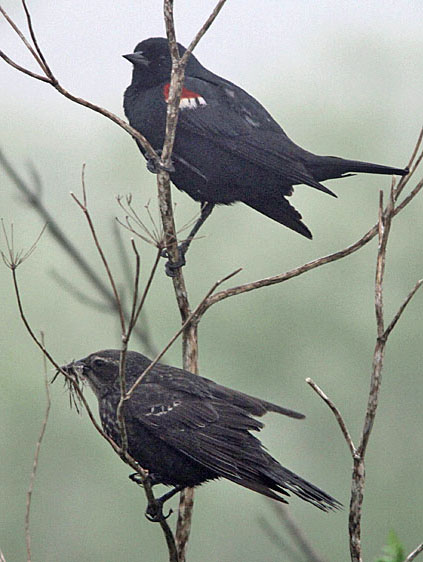 Perhaps the most familiar icterid in North America is Red-winged Blackbird (male left and female right, above). Yet there is substantial variation in this species. The male shown (above left) is of our "Bicolored" population in central California, in which the red epaulets on the wings lack the broad yellow outer edge shown by populations throughout the rest of North America. The female shown (above right) is from Ohio, where the males have yellow edges to red epaulets and females are strongly pattern below.
Perhaps the most familiar icterid in North America is Red-winged Blackbird (male left and female right, above). Yet there is substantial variation in this species. The male shown (above left) is of our "Bicolored" population in central California, in which the red epaulets on the wings lack the broad yellow outer edge shown by populations throughout the rest of North America. The female shown (above right) is from Ohio, where the males have yellow edges to red epaulets and females are strongly pattern below.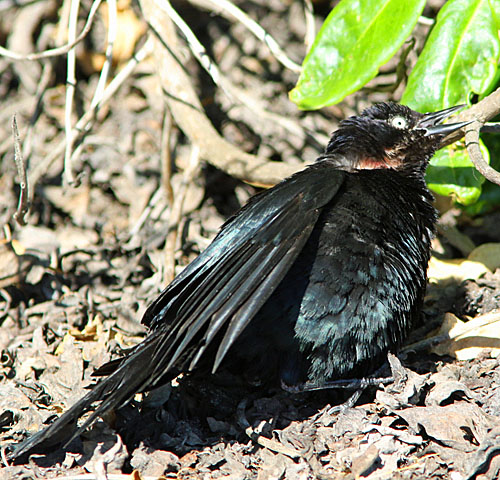 In western North America, a common blackbird is Brewer's Blackbird: a male taking a sunbath, and showing some of its glossy sheen (left). At various times its white eye gives it a "crazed" appearance for a very sober bird, and no more so than taking an actual bath (below).
In western North America, a common blackbird is Brewer's Blackbird: a male taking a sunbath, and showing some of its glossy sheen (left). At various times its white eye gives it a "crazed" appearance for a very sober bird, and no more so than taking an actual bath (below).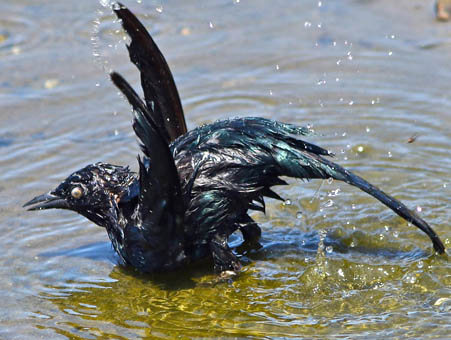
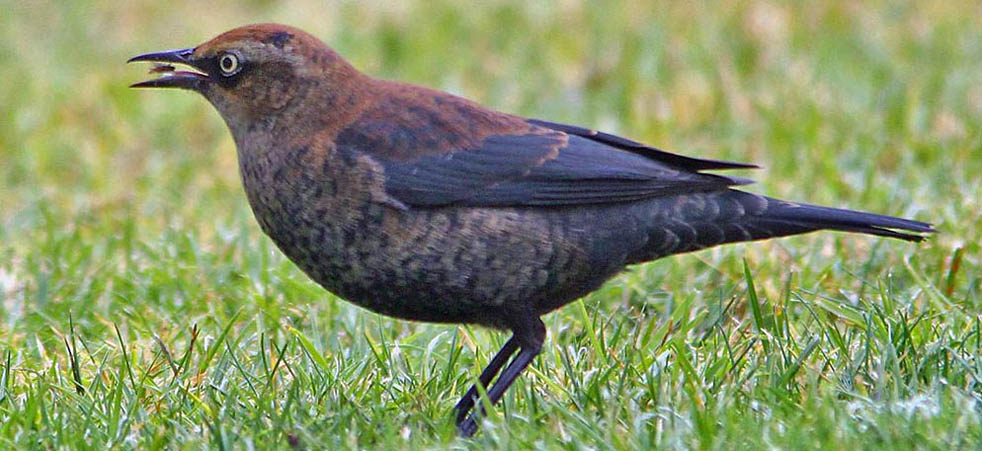

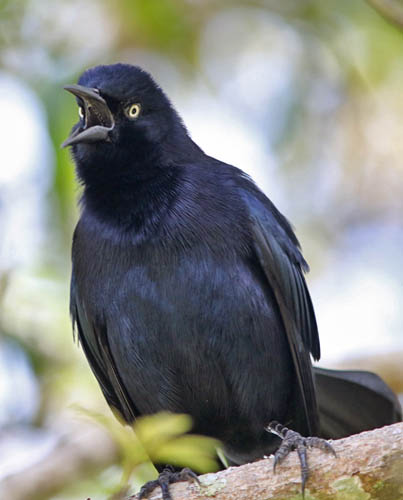 The final group of icterids to mention are six species of big lumbering grackles in the genus Quiscalus. In this genus males are larger than females, and the largest is Great-tailed Grackle (above, a male in display). It ranges from southwestern North America to northwestern South America. In the United States it has extended its range dramatically. Once confined to Arizona and Texas, it has spread throughout California in my lifetime. The first immigrants reached my home county (Monterey) in the mid-1990s, and have since established small breeding colonies in local reed-patches around freshwater ponds and small lakes.
The final group of icterids to mention are six species of big lumbering grackles in the genus Quiscalus. In this genus males are larger than females, and the largest is Great-tailed Grackle (above, a male in display). It ranges from southwestern North America to northwestern South America. In the United States it has extended its range dramatically. Once confined to Arizona and Texas, it has spread throughout California in my lifetime. The first immigrants reached my home county (Monterey) in the mid-1990s, and have since established small breeding colonies in local reed-patches around freshwater ponds and small lakes.